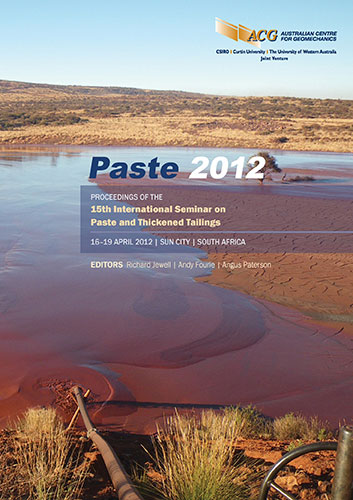Accelerated consolidation of soft clays and mine tailings using a desktop centrifuge

|
Authors: Reid, D; Fourie, AB; Watson, S |
DOI https://doi.org/10.36487/ACG_rep/1263_04_Reid
Cite As:
Reid, D, Fourie, AB & Watson, S 2012, 'Accelerated consolidation of soft clays and mine tailings using a desktop centrifuge', in R Jewell, AB Fourie & A Paterson (eds), Paste 2012: Proceedings of the 15th International Seminar on Paste and Thickened Tailings, Australian Centre for Geomechanics, Perth, pp. 43-52, https://doi.org/10.36487/ACG_rep/1263_04_Reid
Abstract:
Many mine tailings streams contain appreciable quantities of clay minerals, examples including mineral sands fines, diamond and coal tailings. Tests to determine appropriate consolidation properties for these materials, as well as natural clays, are usually very time-consuming and the availability of equipment (such as a Rowe Cell) can sometimes be a limiting factor. This paper describes the development and testing of a modified desktop centrifuge that should eventually allow the determination of a full suite of consolidation material parameters within two days for soils of very low permeability and stiffness. The results of a series of consolidation tests using the desktop centrifuge are presented. The void ratio-effective stress profile is developed from these tests based on centrifuge theory and direct moisture content measurement. Development of a numerical model of the system to allow estimates of the permeability – effective stress profile of tested slurries is currently underway. Encouraging results have been obtained, indicating the ability of this method to provide reasonable results in the time frame outlined. Suggestions for further developments related to this procedure planned at The University of Western Australia (UWA) are outlined.
References:
El-Shall, H., Moudgil, B. and Bogan, M. (1996) Centrifugal modelling of the consolidation of solid suspensions, Minerals and Metallurgical Processing SME, Vol. 13, pp. 98–102.
Ko, H.Y. (1988) Summary of the state of the art in centrifuge modelling, in Centrifuges in soil mechanics, W.H. Craing, R.G. James and A.N. Schofield (eds), Taylor and Francis.
Lehane, B.M., O’Loughlin, C.D., Gaudin, C. and Randolph, M.F. (2009) Rate effects on penetrometer in kaolin, Geotechnique ICE, Vol. 59, pp. 41–52.
McDermott, I.R. and King, A.D. (1998) Use of a bench-top centrifuge to assess consolidation, in Proceedings of Tailings and Mine Waste ’98 – 5th International Conference, 26–28 January 1998, Fort Collins, Colorado.
Muir Wood, D. (2004) Geotechnical Modelling, E&FN Spon Press, London, 504 p.
Schofield, A.N. (1980) Cambridge geotechnical centrifuge operations, Geotechnique ICE, Vol. 30, pp. 227–268.
Stewart, D.P. (1990) Lateral loading of piles in soft clay due to nearby embankment construction, Research report GEO: 90086, Department of Civil and Resource Engineering, The University of Western Australia.
Takada, N. and Mikasa, M. (1986) Determination of consolidation parameters by self-weight consolidation test in centrifuge, in Consolidation of Soils: Testing and Evaluation, ASTMSTP 892, R.N. Yong and F.C. Townsend (eds).
© Copyright 2025, Australian Centre for Geomechanics (ACG), The University of Western Australia. All rights reserved.
View copyright/legal information
Please direct any queries or error reports to repository-acg@uwa.edu.au
View copyright/legal information
Please direct any queries or error reports to repository-acg@uwa.edu.au